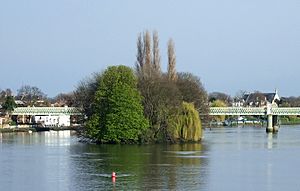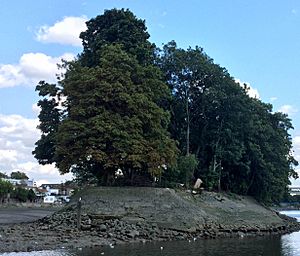Oliver's Island facts for kids

Oliver's Island is a small, tree-covered island in the River Thames in England. It's about 0.9 acres, which is roughly the size of a football field. You can find it in London, within the London Borough of Hounslow. The island faces Kew and Strand-on-the-Green across the river. The Port of London Authority owns this little piece of land.
What is Oliver's Island Like?
This island is covered in thick trees, making it a safe home for many birds. You might spot herons, cormorants, and Canada geese living there. The island sits right in the middle of the river. It is equally far from Priory Park Allotments, Kew, and Strand-on-the-Green.
How Did Oliver's Island Get Its Name?
Oliver's Island gets its name from an old story. People used to say that Oliver Cromwell, a famous English leader from the 1600s, once hid there. However, this story is probably not true!
For a long time, the island was called Strand Ayt. This name was used until about 100 years after the English Civil War. That's when the myth about Cromwell started. Some people even added to the story, saying a secret tunnel connected the island to a nearby inn called the Bull's Head. But no one has ever found any evidence of such a tunnel.
A Brief History of Oliver's Island
In 1777, the City of London's river committee set up a tollbooth on the island. This was a wooden building that looked like a small castle. Its purpose was to collect money from boats passing by. This money helped pay for improvements to the river, making it easier for boats to travel. A special barge, called the "City Barge," was moored next to the island to collect these tolls. This barge even gave its name to an inn nearby!
Later, other barges were used to collect tolls here. Eventually, a proper dock was built on the south side of the river. By 1865, a smithy (a place where metal is worked) was on the island. It became a place where barges were built and repaired.
In 1857, the Thames Conservancy took over managing the river. In 1909, they gave the island to the Port of London Authority (PLA). The PLA used the island's small building for storage. They also used its shores as a wharf, with a crane, for old boats.
In 1971, the PLA tried to sell the island. But local residents, through a group called the Strand on the Green Association, protested strongly. The plan to sell the island was quickly stopped. The old smithy building was taken down in 1990.


